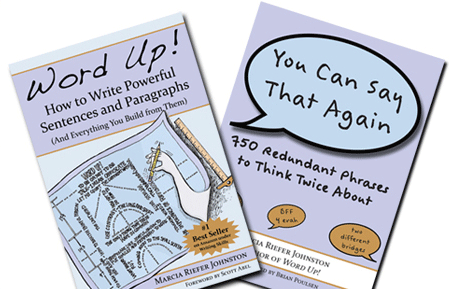Go to the A-Z page | Get the book: Word Up!
unit modifier
See compound modifier.
verb
To call any word a verb is ambiguous. Is it a verb in form? In function? Both?
Verb in form: A form-class word (shovel, feel, seem) that can change form, in natural usage, in ways characteristic of verbs. In other words, a verb in form is a word that has verb features of form. In isolation, it can pass linguistic tests for verbness. Shovel, the standalone word, qualifies as a verb in form (example tests: shovel+s = third-person singular; shovel+ing = present participle). Of course, shovel also qualifies as a noun in form; like many English words, it belongs to multiple form classes.
Verb in function: Any word or phrase that acts as a main verb in a phrase or clause. A verb in function typically designates actions, sensations, or states. In Carl has been shoveling all morning, the word shoveling is a verb not only in form (it ends with –ing) but also in function because it designates Carl’s action.
Part of determining a verb’s function is identifying whether it acts as a linking verb, a transitive verb, or an intransitive verb. In Carl has been shoveling all morning, shoveling plays an intransitive rolebecause it has no direct object. Incidentally, the other two verbs—has and been—belong (by virtue of their position directly in front of the main verb) not to the form class known as verbs but to the structure class known as auxiliaries, a separate grammatical entity.
Verbs, the most complicated part of speech, have several other attributes: voice, tense, aspect, and mood.
See also phrasal verb. For more, see the chapter “A Modern Take (Is Take a Noun?) on Parts of Speech” in Word Up!
verb particle
A word that works with a main verb, and sometimes with other words, to create a phrasal verb. For example, in the phrasal verb chip in (“help”), in is a verb particle. In the phrasal verb drop out of (“quit”), out and of are verb particles.
For more, see the chapter “You Don’t Know From Prepositions” in Word Up!
voice
- A verb attribute that relates the subject to the action. Voice comes in two types: active and passive.
.
Compare aspect, mood, and tense. See also auxiliary.
. - The writer’s personality (supposedly) coming through in the words Voice and tone are sometimes used synonymously. Those who differentiate between them say that tone is the writer’s attitude toward the subject or audience in a given piece (or, more accurately, the feelings that the piece stirs in the reader, the only thing the reader can determine). A reader might perceive that a personal letter, for example, has a conciliatory tone. Tone may change from one piece of writing to another.
.
On the other hand, voice (as in the writer’s personality) theoretically remains constant across a body of work. I don’t know what to make of that claim since writers hardly remain constant across a body of work.
.
Ultimately, both tone and voice emerge from the writer’s entire set of writing decisions—word choice, syntax, sentence length, punctuation, metaphors—everything that Word Up! touches on and more. Base each decision on your purpose and audience. Tone and voice will follow.
. - Corporate voice, the personality of an organization. An organization’s writers need style guidelines to help them keep their writing consistent and on brand. If they’re lucky, they also have editors—not robotic style-checking programs, which catch only the most basic of faux pas, but human editors, people who possess command of the language, people who know from voice.
This is not a list of all words about writing—you’d be scrolling all day. These definitions evolved while I was writing Word Up! I enjoyed what I learned and wanted to share it.
Get the full glossary and more in the book: Word Up! How to Write Powerful Sentences and Paragraphs (And Everything You Build from Them)


